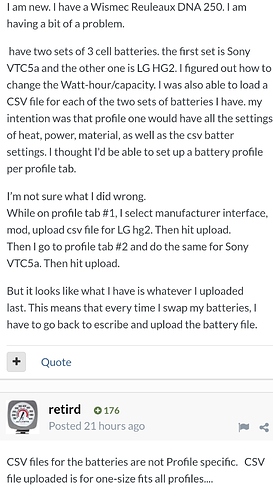Most of this is just general information to “the public at large” (especially since it appears you have the idea down)… But I thought some things might be worth adding to the topic for clarification of anyone who might still be uncertain of the purpose (and usefulness) of battery profiles.
Correct, and yes, that’s how you’d want to use them! (For example, I’d name one battery profile “250c, LG-H2, 3 batt”, and the other “250c, SonyVTC5a, 3 batt”)
EG:
Profile 1 uses the LG HG2 3-battery profile, with the intent of being used in TC mode.
Profile 2 uses the LG HG2 3-battery profile, in power mode.
Profile 3 uses the Sony VTC5a 3-battery profile, in TC mode.
Profile 4 uses the Sony VTC5a 3-battery profile, in power mode.
My reasoning behind the particular naming layout (above) is, if you start accumulating more DNA devices (which is likely), you’ll begin to have more battery profiles.
The thing is, you’re still going to have to run the Battery Analyzer for each brand, and model of battery. (Or find the 3 battery profile for it)
Once you have the base profiles built up, they’re designed to be “universal” across DNA devices.
The only other distinguishing characteristic (in the case of 18650’s) is how many cells (batteries) the device uses:
Any single cell profile (think 75c) should work the same* in any 1 cell DNA device, (regardless of device branding: Wismec, Hcigar, LostVape, etc), as long as the chosen battery brand and model are the same.
Any dual cell profile (eg: 200, 133, 166) should work the same* in any 2 cell DNA device, (regardless of device branding), as long as the chosen battery brand and model are the same.
Any triple cell profile (250c) should work the same* in any 3 cell DNA device, (regardless of device branding), as long as the chosen battery brand and model are the same.
/* note = bear in mind, that due to hardware revisions, there may be a slight variance in accuracy of the battery meter, due to the fact that the efficiency of certain devices has been reported as being up to 15% different!!
So, depending on how different (and how much this affects things [read as: actual performance, or just OCD]) you may need/want to have a separate profile to account for the efficiency difference.
I don’t have the firsthand experience across the range of DNA devices to comment with certainty, which is why I’m noting the possibility of such being a factor.
It’s also why I’m suggesting the naming convention above. So you don’t have to go back and relabel (or worse, redo the actual battery analyzer tests) IF it turns out that the efficiency of a given board series is different enough to warrant requiring a unique profile.
